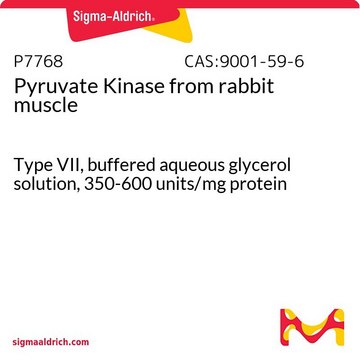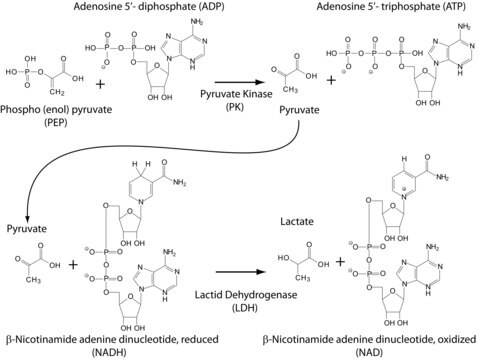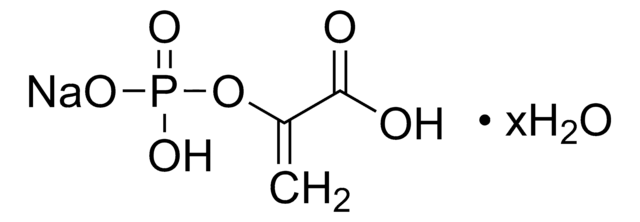P1903
Pyruvate Kinase from Bacillus stearothermophilus
Type VIII, lyophilized powder, 100-300 units/mg protein
Synonym(s):
ATP:pyruvate 2-O-phosphotransferase, PK
Sign Into View Organizational & Contract Pricing
All Photos(1)
About This Item
Recommended Products
biological source
Bacillus sp. (B. stearothermophilus)
type
Type VIII
form
lyophilized powder
specific activity
100-300 units/mg protein
storage temp.
2-8°C
General description
Research Area: CELL SIGNALING
Mammalian pyruvate kinase is a tetrameric protein composed of identical subunits organized in a dimer-of-dimers configuration. Four isoforms of pyruvate kinase exist in mammals, namely PKM1, PKM2, PKR, and PKL. Pyruvate kinase can be found in both tetrameric and dimeric forms.
Mammalian pyruvate kinase is a tetrameric protein composed of identical subunits organized in a dimer-of-dimers configuration. Four isoforms of pyruvate kinase exist in mammals, namely PKM1, PKM2, PKR, and PKL. Pyruvate kinase can be found in both tetrameric and dimeric forms.
Application
Pyruvate Kinase from Bacillus stearothermophilus may be used in biofuel production.
Pyruvate kinase from Bacillus stearothermophilus has been used in a study to assess evidence that the genes for phosphofructokinase and pyruvate kinase constitute an operon. It has also been used in a study to investigate the importance of the Lys221 active site for pyruvate kinase activity.
Biochem/physiol Actions
Pyruvate Kinase from Bacillus stearothermophilus is activated by AMP and ribose 5-phosphate.
Pyruvate kinase is an enzyme that facilitates the conversion of phosphoenolpyruvate (PEP) and ADP to pyruvate and ATP in glycolysis and is involved in the regulation of cell metabolism. It serves as a terminal enzyme in the glycolytic pathway. This reaction is favorable due to the high energy of hydrolysis of PEP.
Pyruvate kinase is a key regulator controlling metabolic flux and ATP production in glycolysis and is considered a potential drug target. Additionally, pyruvate kinases are subject to regulation by heterotropic effectors, with fructose 1,6-bisphosphate (FBP) being the most widely known allosteric activator of bacterial, yeast, and mammalian enzymes. Furthermore, PKM2, one of the four isoforms of pyruvate kinase, is extensively expressed in various types of tumors and is associated with tumorigenesis.
Pyruvate kinase is a key regulator controlling metabolic flux and ATP production in glycolysis and is considered a potential drug target. Additionally, pyruvate kinases are subject to regulation by heterotropic effectors, with fructose 1,6-bisphosphate (FBP) being the most widely known allosteric activator of bacterial, yeast, and mammalian enzymes. Furthermore, PKM2, one of the four isoforms of pyruvate kinase, is extensively expressed in various types of tumors and is associated with tumorigenesis.
Unit Definition
One unit will convert 1.0 μmole of phospho(enol)pyruvate to pyruvate per min at pH 7.2 at 30 °C.
Physical form
Lyophilized powder containing Tris buffer salts, pH 8.5
Analysis Note
Protein determined by biuret
Storage Class Code
11 - Combustible Solids
WGK
WGK 3
Flash Point(F)
Not applicable
Flash Point(C)
Not applicable
Personal Protective Equipment
dust mask type N95 (US), Eyeshields, Gloves
Choose from one of the most recent versions:
Already Own This Product?
Find documentation for the products that you have recently purchased in the Document Library.
Customers Also Viewed
E W Walters et al.
Plant physiology, 114(2), 549-555 (1997-06-01)
Adenylosuccinate synthetase (AdSS) is the site of action hydantocidin, a potent microbial phytotoxin. A kinetic analysis of the mode of inhibition of a plant adenylosuccinate synthetase by the active metabolite 5'-phosphohydantocidin (5'-PH) was the objective of the present study. AdSS
Molecular cloning and nucleotide sequence of the gene for pyruvate kinase of Bacillus stearothermophilus and the production of the enzyme in Escherichia coli. Evidence that the genes for phosphofructokinase and pyruvate kinase constitute an operon
Sakai, H. and T. Ohta
FEBS Journal, 211, 851-859 (1993)
Crystallization and preliminary X-ray analysis of pyruvate kinase from Bacillus stearothermophilus
Suzuki, K.
Acta Crystallographica Section B, Structural Crystallography and Crystal Chemistry, F61, 759-761 (2005)
Mutagenesis of the active site lysine 221 of the pyruvate kinase from Bacillus stearothermophilus
Sakai, H.
The Journal of Biological Chemistry, 137, 141-145 (2005)
Nicolas Galazis et al.
European journal of endocrinology, 168(2), R33-R43 (2012-10-25)
Women with polycystic ovary syndrome (PCOS) are at increased risk of developing insulin resistance and type 2 diabetes mellitus (T2DM). In this study, we attempted to list the proteomic biomarkers of PCOS and T2DM that have been published in the
Our team of scientists has experience in all areas of research including Life Science, Material Science, Chemical Synthesis, Chromatography, Analytical and many others.
Contact Technical Service













